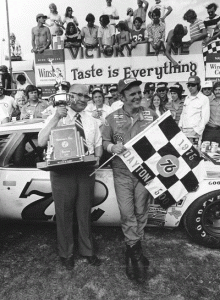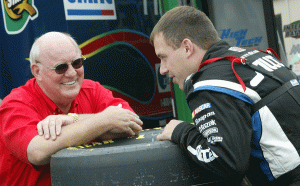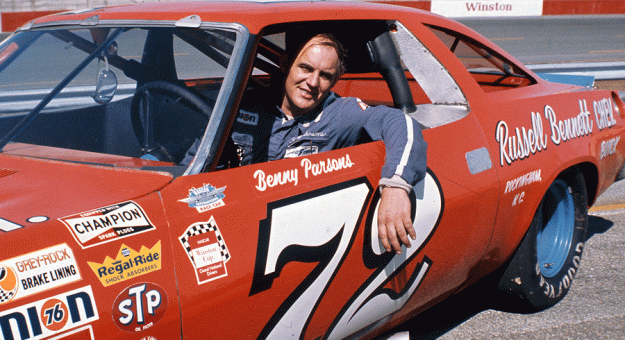On a Friday afternoon in the summer of 1963, Benny Parsons was working at his father Harold’s Pure Oil gas station that also served as the family taxi business in Detroit.
Eventually a friend stopped by to fill up a race car transporter en route to an event in West Virginia, and Parsons was invited to tag along.
When the car owner, Dick Gold, looked around for his driver for the figure-8 race, he was nowhere to be found. There stood 21-year-old Benjamin Stewart Parsons, beaming from ear to ear as he stared at the empty seat in the 1954 Ford. In the blink of an eye, a racing career was born.
There were many race tracks in southern Michigan and northern Ohio, and when Harold Parsons paid $1,500 for a late model 1956 Ford, Benny Parsons immediately began winning races. He quickly caught the eye of Ford Motor Co. executives who offered him a NASCAR Cup Series ride with the famed Holman Moody operation in Charlotte, N.C.
Parsons made his series debut at Asheville-Weaverville (N.C.) Speedway on Aug. 9, 1964. Overheating sent him to the garage early, curtailing his entrance into NASCAR’s elite top level for another six years, as Ford executives selected a promising short-track racer and floor sweeper at Holman Moody named Cale Yarborough for a full-time ride.
Parsons was named ARCA rookie of the year in 1965 and he won series championships in 1969 and ’70. He entered four Cup Series races with team owner Russ Dawson in 1969.
When Buddy Young was killed at California’s Riverside Int’l Speedway in January 1970, Parsons contacted team owner L.G. Dewitt and a deal was struck for Parsons to drive for the team based in Ellerbe, N.C. Parsons and his family moved to Ellerbe and his Cup Series career began taking shape.
He won his first Cup Series race on March 9, 1971, at South Boston (Va.) Speedway after leading 42 of 281 laps.

Parsons won at Bristol (Tenn.) Motor Speedway and earned 15 top-five finishes en route to winning the Cup Series championship in 1973. Those accomplishments are greatly overshadowed by what occurred in the final race of the season at Rockingham Speedway.
On the 13th circuit of the 492-lap race, Johnny Barnes spun and collected Parsons’ No. 72 Chevrolet, reducing it to a pile of junk. Crew members from several teams pitched in and changed the rear-end housing, rear axle, sway bars and steering and welded a set of left-side door bars in place, which were “borrowed” from Bobby Mausgrover’s Dodge that failed to qualify for the race.
After an hour and a half, sweat soaked, grime-covered mechanics got Parsons back on the track, 136 laps down. Parsons kept the car on the track and secured the championship by 67 points over Yarborough, who was driving Junior Johnson’s No. 11 Chevrolet.
“There have been several times in my life that I’ve thought the best thing I could do was walk away from a racing career,” Parsons said. “Those moments have come at almost every level on my way to NASCAR Winston Cup racing, but for some reason, I could never quit. In my mind, I would have been a loser or a quitter if I had given up and not given racing that final, all-out last gasp chance to see if I could be successful.”
Bobby Allison, the 1983 Cup Series champion, remembers the day Parsons clinched the title.
“I thought it was a great show of sportsmanship that so many people went over to help Benny win the championship that day,” Allison said. “Crew members from so many teams stepped in and immediately assessed the situation and went to work and got him back on the track. That said so much about how much they thought of Benny. They were competitors of Benny’s and yet they helped him win the championship. Even some of my crew was there helping him. He was an incredible friend and an incredible racer.”
On Feb. 16, 1975, Parsons was running second to David Pearson in the Daytona 500 when Pearson spun the Wood Brothers Racing Mercury with three laps remaining. Parsons took the lead and won the biggest race of his career.
“This is fantastic,” Parsons said. “This is it. This is the biggest day of my life, better than winning the 1973 Winston Cup championship.”
Possibly the most intense race of Parsons’ career came when he won the 1980 Coca-Cola 600 at Charlotte Motor Speedway. Driving for team owner M.C. Anderson, Parsos and Darrell Waltrip, wheeling the No. 88 Digard Racing Chevrolet, waged an intense battle for the victory.
“The cars were so doggone equal there at the end of the race I knew that I could not hold him back,” Parsons said in 2002. “I knew that if I slipped a little bit or if I picked up a little bit of a push, if I got a little bit loose or even just cracked the throttle for an instant, he was going to pass me. I also knew the same thing was true for him.
“If the least little thing happened, I was going to be able to pass him. We could pass at will. The last 25 laps were amazing,” Parsons said. “Again, the cars were absolutely equal and you had to drive just an absolute perfect lap. Otherwise, the other guy was going to pass you. Sometimes, I thought I drove the perfect lap. And here Darrell would come and pass me back.”
Parsons collected 21 Cup Series victories. He concluded his career with team owner Junie Donlavey at the end of the 1988 Cup Series season.

As far back as 1979, Parsons showed he was a natural as a radio and television broadcaster and moved into that role after leaving the driver’s seat. While still racing part time in the 1980s, Parsons began a transition into broadcasting, first working as a pit reporter for ABC and ESPN and also TBS and TNT.
After retiring from full-time racing, Parsons worked as an on-air broadcaster for ABC-ESPN until 2001 when he went to work for NBC and TNT. Sadly, Parsons died from complications of cancer on Jan. 16, 2007.
Rusty Wallace, NASCAR’s 1989 Cup Series champion, has also worked in television broadcasting and is currenting lead analyst with Motor Racing Network. He raced against Parsons for many years.
“Benny was an awesome guy to be around,” Wallace said. “He was a bigger than life person as far as his stature. Race car drivers seem to be smaller physically, but Benny was a big, muscular guy that got it done in a race car. I remember him hauling it around places like Darlington and tracks like that. That’s what sticks out to me as far as Benny the race driver.
“As far as Benny the person, you couldn’t ask for a nicer guy,” Wallace added. “You could tell the announcing on radio and television was something he really enjoyed doing. He really cared about doing that. When Benny was doing that, you could be what you wanted to be back in the ESPN days. It was a little rougher around the collar, so to speak, then. You could be yourself a little more back then. He dominated as a broadcaster. I loved his broadcasting. He had such a dominant personality when you met him.”
Dr. Jerry Punch, a longtime pit reporter over the past 40 years, worked with Parsons and considered him a very close friend.
“Benny was so great at what he did as a race car driver and as an announcer,” Punch said. “He was such a natural behind the microphone and that’s why people loved him so much. But something else I loved about him was that he could be in the garage area after being in a crash and his car would be sitting on jack stands beat all to pieces and he would be sitting inside the race car.
“I would put the microphone inside the car and ask him what happened, and he would describe the crash to me or either he would say, ‘Jerry, I just don’t know.’ He never got mad or upset. I never, ever saw him upset about anything after a crash. He would never bad mouth anyone. I honestly never remember him ever doing that anytime I interviewed him. He was an amazing guy. And a great friend. I really miss him.”
